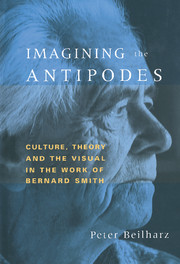Book contents
- Frontmatter
- Contents
- Preface
- Introduction
- Chapter 1 Beginnings
- Chapter 2 Encountering Australian Painting
- Chapter 3 Imaging the Pacific
- Chapter 4 The Antipodean Manifesto
- Chapter 5 Death of the Hero as Artist
- Chapter 6 Modernity, History and Postmodernity
- Chapter 7 Conclusions – Imagining the Antipodes
- Notes
- Index
Chapter 7 - Conclusions – Imagining the Antipodes
Published online by Cambridge University Press: 22 September 2009
- Frontmatter
- Contents
- Preface
- Introduction
- Chapter 1 Beginnings
- Chapter 2 Encountering Australian Painting
- Chapter 3 Imaging the Pacific
- Chapter 4 The Antipodean Manifesto
- Chapter 5 Death of the Hero as Artist
- Chapter 6 Modernity, History and Postmodernity
- Chapter 7 Conclusions – Imagining the Antipodes
- Notes
- Index
Summary
What might it mean to imagine the antipodes? Where have we come from, and where are we going? What provisional conclusions might then be drawn from this study? There are many, for Smith's is a rich body of work. There are some that concern social theory in Australia, and which affect the conduct of theory more generally. My claim in this book is that Bernard Smith's work adds up to the most sophisticated social theory which has yet been developed in Australia; and given that antipodean means European as well as Australian, this argument means that I am valuing his work very highly. But how might the project be characterised? I have suggested Smith's project is a peculiar kind of Marxism which works like a sponge or net; what is striking about Smith's Marxism is that, like Marx's, it is filled up with other things and ways of thinking rather than with authorised Bolshevik canon and the routine list of compulsory categories. Je ne suis pas marxiste is a description which fits Smith's work as well as it does that of Karl Marx. Yet to view Smith's work as social theory is also to open some obvious but protected questions as to the nature of theory. I have suggested that Smith's work has several more or less distinct audiences among anthropologists, art historians and those perhaps interested in biography or in Australian studies.
- Type
- Chapter
- Information
- Imagining the AntipodesCulture, Theory and the Visual in the Work of Bernard Smith, pp. 183 - 193Publisher: Cambridge University PressPrint publication year: 1997



